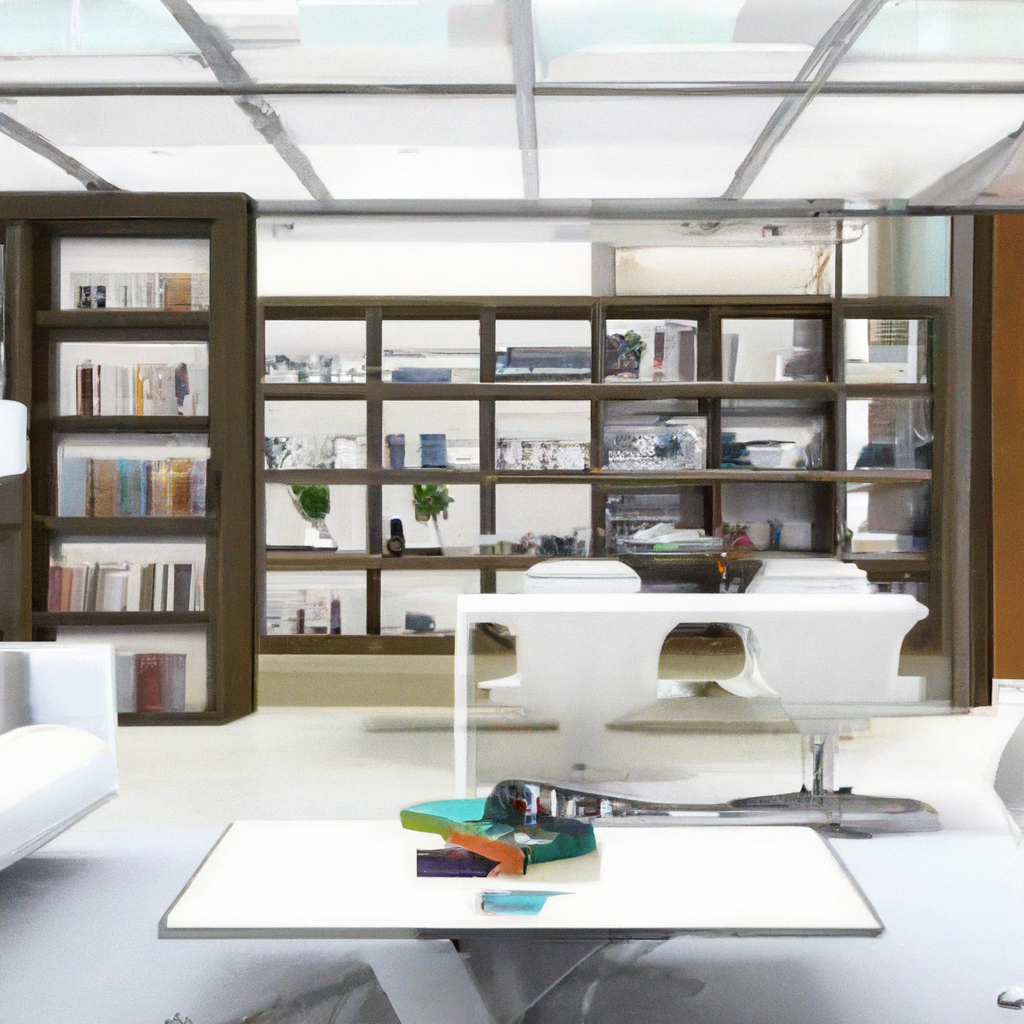Imagine having the perfect setup in your own living room that allows you to seamlessly transition between work and relaxation. In today’s digital age, with an increasing number of people working remotely, creating a smart living room that promotes productivity is more important than ever. From ergonomic furniture to innovative technology, this article will guide you on how to design a smart living room that optimizes your remote work experience and boosts your productivity levels. Say goodbye to the distractions and discomfort of traditional workspaces, and say hello to a productive and comfortable environment right in the heart of your home.

1. Creating a Functional Layout
Choosing the right furniture
When designing a smart living room for remote work and productivity, it’s essential to choose the right furniture that suits your needs. Consider investing in a comfortable and supportive chair that promotes good posture during long working hours. Look for ergonomic features such as adjustable height and lumbar support. Additionally, select a desk that provides ample surface area for your equipment and paperwork. A spacious and organized workspace is crucial for staying productive and focused.
Organizing workspace and relaxation areas
A well-organized living room can significantly impact your productivity. Create designated areas for work and relaxation to differentiate between your professional and personal space. Arrange your desk in a quiet corner, away from distractions. Use storage solutions like shelves or cabinets to keep your work materials and supplies organized and easily accessible. Designate a separate area for relaxation, where you can unwind and take breaks during the workday.
Considering lighting and natural light
Proper lighting is crucial for both productivity and overall well-being. Take advantage of natural light by positioning your workspace near a window. Natural light has been proven to boost mood, increase productivity, and reduce eye strain. In addition, consider incorporating adjustable lighting options to accommodate different tasks and preferences. Task lighting such as desk lamps can provide focused illumination for detailed work, while ambient lighting can create a soothing and comfortable atmosphere.
2. Establishing a Distraction-free Environment
Minimizing noise
Creating a distraction-free environment is essential for remote work. Minimize noise by selecting a secluded area of your living room to set up your workspace. Avoid high-traffic areas or rooms with constant interruptions. If you encounter external noise, consider using noise-cancelling headphones to block out distractions. You can also use white noise machines or calming background music to create a more serene work environment.
Setting boundaries
Working from home can blur the lines between work and personal life. Establish clear boundaries to maintain a healthy work-life balance. Communicate your remote work schedule to family members or roommates, and request their cooperation in minimizing interruptions during designated work hours. Consider creating a visual indicator, such as a “do not disturb” sign, to signal when you are in focus and should not be disturbed.
Eliminating visual distractions
A cluttered and visually chaotic environment can hinder productivity. Keep your living room tidy and free from unnecessary visual distractions. Use storage solutions and furniture with hidden compartments to keep your workspace organized and visually clean. Additionally, consider using curtains or blinds to control external distractions and create a calm atmosphere.

3. Incorporating Ergonomic Furniture and Equipment
Investing in a comfortable chair
Considering the amount of time you spend sitting while working remotely, investing in a comfortable chair is crucial. Look for chairs with adjustable features, such as height, armrests, and lumbar support. A well-designed ergonomic chair can prevent back and neck pain, promote good posture, and enhance productivity by providing adequate support and comfort.
Selecting an appropriate desk
Choosing the right desk is equally important for ergonomic remote work. Look for a desk that provides enough space for your work essentials, including your laptop, monitor, keyboard, and documents. Consider adjustable desks that allow you to switch between sitting and standing positions, promoting movement and reducing the negative effects of prolonged sitting. Additionally, opt for desks with cable management solutions to keep your workspace neat and organized.
Choosing adjustable monitor stands
Proper positioning of your monitor is crucial for maintaining good posture and reducing eye strain. Invest in adjustable monitor stands that allow you to position your screen at eye level to avoid neck and back strain. These stands also help maximize desk space by freeing up valuable surface area. Consider using a secondary monitor for increased productivity and multitasking capabilities.
4. Enhancing Connectivity and Technology
Ensuring strong and reliable Wi-Fi
A stable and fast internet connection is vital for remote work. Ensure your living room has reliable Wi-Fi coverage by positioning your router in a central location or using Wi-Fi extenders if needed. Check the signal strength and stability in your workspace to avoid disruptions during important video calls or online collaborations. Consider upgrading to a high-speed internet plan if necessary.
Equipping the room with charging stations
With multiple devices used for remote work, it’s essential to have convenient charging options readily available. Set up charging stations in your living room for laptops, smartphones, tablets, and other devices you frequently use. Use cable management solutions to keep the charging cables organized and prevent clutter. This way, you can easily keep your devices powered and avoid the hassle of searching for charging outlets or untangling cables.
Integrating smart devices and voice assistants
Take advantage of smart home technology to enhance your remote work experience. Integrate voice assistants like Amazon Echo or Google Home to control various aspects of your living room, such as lighting, temperature, and entertainment systems. Use smart plugs or smart power strips to manage and control your devices remotely. These technologies can help streamline different tasks, increase efficiency, and create a more intuitive work environment.

5. Maximizing Storage and Organization
Utilizing multifunctional furniture
Incorporate multifunctional furniture to maximize storage and organization in your living room. Look for coffee tables with built-in drawers or shelving units that can store work materials or office supplies. Opt for sofas or ottomans with hidden storage compartments to keep your living room clutter-free. By combining functionality and style, you can create a space that accommodates both your work and relaxation needs.
Implementing effective cable management solutions
Cables and cords can quickly create a messy and tangled appearance. Implement effective cable management solutions to keep your living room neat and organized. Use cable clips or cable sleeves to bundle and hide cables behind furniture or along the walls. Consider using wireless technology where possible to minimize the need for cables and cords. A clutter-free workspace promotes a sense of calm and enhances productivity.
Organizing documents and supplies
Proper organization of documents and supplies is essential for remote work. Use file organizers, folders, or binders to keep your important documents organized and easily accessible. Label drawers or storage containers to categorize different supplies, such as pens, notebooks, or chargers. Dedicate a specific area or shelf for your work-related materials to maintain an efficient and clutter-free workspace.
6. Designing for Productivity and Inspiration
Selecting motivating colors and decor
The colors and decor of your living room can significantly impact your mood and motivation. Choose colors that promote productivity and focus, such as shades of blue or green. Incorporate motivational quotes or artwork that inspires creativity and ambition. Personalize your workspace with items that bring you joy and reflect your personality. By creating a visually stimulating and inspiring environment, you can enhance your productivity and overall well-being.
Incorporating plants or natural elements
Introducing plants or natural elements into your living room can have numerous benefits for remote work. Plants not only improve air quality but also add texture and visual appeal to your space. Greenery has been shown to reduce stress and enhance cognitive function, making it an ideal addition to a productive workspace. Consider low-maintenance plants like succulents or spider plants that thrive in indoor environments.
Creating a dedicated brainstorming or idea board
A dedicated space for brainstorming and capturing ideas can be immensely beneficial for remote work. Designate an area in your living room to create a brainstorming or idea board. Use a whiteboard, corkboard, or digital equivalent to jot down thoughts, inspiration, or important tasks. Having a visible and accessible space for creativity and ideation encourages innovation and helps you stay organized and focused.

7. Prioritizing Comfort and Well-being
Adding comfortable seating options
Apart from your designated workspace, it’s essential to have comfortable seating options in your living room. Consider adding a cozy armchair or a comfortable sofa where you can relax during breaks or after work hours. Opt for furniture with plush cushions and adjustable backrests to ensure maximum comfort. By prioritizing comfort in your living room, you create an inviting space that supports relaxation and rejuvenation.
Including adjustable lighting options
Lighting plays a crucial role in creating a comfortable and productive living room. Incorporate adjustable lighting options to cater to different tasks and moods. Use dimmable overhead lights or floor lamps with adjustable settings to control the ambiance. Warm lighting can promote relaxation and calm, while brighter lighting can enhance focus and alertness. By having control over the lighting, you can create a personalized and comfortable environment for remote work.
Incorporating relaxation zones or meditation space
Remote work can sometimes be stressful, and it’s essential to have areas in your living room dedicated to relaxation and well-being. Create a cozy nook with soft pillows and blankets where you can unwind and take short breaks. Consider incorporating a meditation or yoga space, complete with a comfortable mat or cushion. By prioritizing relaxation and well-being, you can recharge and maintain a healthy work-life balance.
8. Enhancing Privacy and Acoustics
Installing soundproofing materials
Privacy and acoustics are crucial for a productive living room workspace. If you share your living space with others, consider installing soundproofing materials such as acoustic panels or curtains to minimize noise disruptions. These materials absorb sound, reducing echoes and external noise. Additionally, consider using a white noise machine or playing soft background music to create a more tranquil and focused environment.
Using curtains or blinds for privacy
Maintaining privacy in your living room is essential, especially if you have open-concept or shared living spaces. Install curtains or blinds that provide privacy when necessary. Opt for blackout curtains that block out unwanted light and distractions during video conferences or when you need to concentrate. By having control over your privacy, you can create a more professional and focused work environment.
Employing noise-cancelling devices
If you frequently encounter loud or distracting noises in your living room, consider using noise-cancelling devices. Noise-cancelling headphones or earbuds can create a bubble of tranquility, allowing you to concentrate on your work without being disturbed by external sounds. Invest in high-quality noise-cancelling technology to create a peaceful and distraction-free workspace.

9. Incorporating Smart Home Automation
Automating lighting and temperature control
Smart home automation can streamline your remote work experience by providing convenient control over lighting and temperature. Use smart light bulbs or smart switches that can be controlled remotely or through voice commands. Set up schedules or routines to automatically adjust the lighting based on your work hours. Similarly, invest in smart thermostats that allow you to control the temperature from anywhere, ensuring a comfortable workspace at all times.
Integrating voice-activated controls
Voice-activated controls can greatly enhance the efficiency and ease of use in your living room workspace. Connect your smart devices with voice assistants like Amazon Alexa or Google Assistant to control various aspects of your living room with simple voice commands. Adjust the lighting, play music, or even order supplies without leaving your desk. By incorporating voice-activated controls, you can optimize your workflow and minimize distractions.
Implementing smart security systems
As technology advances, the importance of cybersecurity and protecting sensitive information becomes increasingly vital. Implement smart security systems in your living room to ensure the safety of your work and personal data. Install smart locks or security cameras that provide remote monitoring and control. Set up alerts and notifications to keep you informed about any potential security breaches. By prioritizing home security, you can work remotely with peace of mind.
10. Considering Future Flexibility and Adaptability
Designing for modular and flexible furniture arrangements
As your remote work needs may evolve over time, it’s essential to design your living room for future flexibility and adaptability. Choose modular furniture that can be easily rearranged or expanded to accommodate changing requirements. Look for sectional sofas, bookshelves with adjustable shelves, or modular desks that can be customized as needed. By designing for flexibility, you can adapt your living room to suit your evolving work and lifestyle preferences.
Creating versatile workspace options
In addition to your designated workspace, consider creating versatile options throughout your living room. Incorporate additional surfaces like side tables or breakfast trays that can serve as temporary workstations when needed. Use lightweight and portable furniture that can be easily moved and adjusted to different locations or tasks. By having multiple workspace options, you can maintain productivity and adapt to different work scenarios.
Providing space for future technological advancements
Technology is constantly evolving, and it’s important to design your living room with future advancements in mind. Ensure that your living room has sufficient electrical outlets and connectivity options to accommodate new devices or technologies. Consider incorporating hidden cable management solutions that can easily adapt to different charging or connectivity requirements. By being prepared for future technological advancements, you can seamlessly integrate new tools and devices into your remote work setup.
In conclusion, designing a smart living room for remote work and productivity requires careful consideration of various factors. From choosing the right furniture to enhancing connectivity and incorporating smart home automation, every aspect plays a crucial role in creating an efficient and comfortable workspace. Prioritizing organization, comfort, privacy, and adaptability will help you create a living room that promotes productivity, creativity, and overall well-being in your remote work journey.
